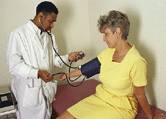Coronary Artery Calcium May Raise Women's Heart Risk
New study challenges traditional assessment of risk.
By Ed Edelson
HealthDay Reporter
|
E-mail this article
Subscribe to news
Printer friendly version
|

(SOURCES: Susan G. Lakoski, M.D., cardiac fellow, Wake Forest University School of Medicine, Winston-Salem, N.C.; Suzanne Steinbaum, director, Women and Heart Disease, Lenox Hill Hospital, New York City; Dec. 10/24, 2007, Archives of Internal Medicine)
MONDAY, Dec. 10 (HealthDay News) -- About 5 percent of women considered at low risk for heart disease still face potential cardiovascular problems because of calcium buildup in their arteries, a new study suggests.
"Previous studies have demonstrated that calcium is predictive of coronary artery disease in other populations," said study lead author Dr. Susan G. Lakoski, a cardiology fellow at the Wake Forest University School of Medicine. "We traditionally have the question of looking at low-risk people."
The standard method of measuring heart risk is the so-called Framingham risk score, which is based on findings of a decades-long study of residents of a Massachusetts town. The score includes such factors as age, cholesterol levels, diabetes, smoking and obesity, but not calcium.
Lakoski and her colleagues used computerized tomography scans of the chest to measure coronary artery calcium in 3,601 women between 45 and 84 years of age. Ninety percent of the women were considered "low risk," because their Framingham scores indicated they had less than a 10 percent chance of a cardiac event in 10 years. (High risk is a test score of 20 percent or higher.)
Over an average of the next 3.75 years, 24 of the low-risk women had heart events -- such as heart pain or a heart attack -- and 34 of the women had a so-called cardiovascular disease event, including heart events, stroke or death, the study found.
Women with the highest calcium scores were especially at risk, Lakoski said. "They had an 8.6 percent risk of a coronary event," she said.
The findings are published in the Dec. 10/24 issue of Archives of Internal Medicine.
Lakoski said it's probably too early to consider routine testing of coronary artery calcium to gauge heart risk for women. The number of study participants was small, and further research is needed, she said.
Still, Dr. Suzanne Steinbaum, director of Women and Heart Disease at Lenox Hill Hospital in New York City, called the study findings important. "The risk of heart disease in women is often underestimated, because they develop heart disease later than men, often at age 65. By measuring calcium, we can show that they might actually be at higher risk, and that is important because they can benefit from preventive measures."
And heart-risk estimates for women based on traditional risk factors might be misleading because of societal changes, Steinbaum said. "Younger women are developing heart disease earlier than we originally thought," she said. "This is where calcium might be an important modality in classifying risk."
A test for coronary artery calcium is easily done, Steinbaum said, but health insurance companies don't currently pay for it.
While there are no known measures to reduce coronary artery calcium, a woman who knows of its presence can still take preventive measures, Lakoski said. "She needs to offset it with lifestyle measures that affect risk factors that are modifiable, such as cholesterol," she said.
More information
To learn more about coronary heart disease, visit the U.S. National Library of Medicine.
Copyright © 2007 ScoutNews, LLC. All rights reserved. 
HealthDayNews articles are derived from various sources and do not reflect federal policy. healthfinder.gov does not endorse opinions, products, or services that may appear in news stories. For more information on health topics in the news, visit the healthfinder.gov health library.